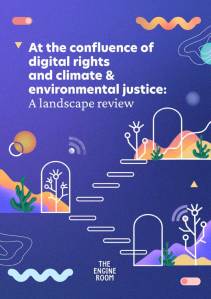Intersections of Digital Rights and Environmental and Climate Justice
We are living in a climate crisis: the science is clear, and we need to rapidly change to a more just and sustainable society. This includes investing in a sustainable internet, which is currently the world’s largest coal-powered machine. More than building sustainable internet infrastructure, we also need to examine how and where the internet aligns with the movements for climate and environmental justice—and where it works against them.
Often considered separately, the environment and the internet share much in common; both are global in scope, linked to the exercise and erosion of human rights, and require international cooperation and coordination for their successful continuance. The repercussions of one can also extend to the other: from water rights disputes between data centers and local residents, to rampant greenwashing misinformation by fossil fuel companies, the internet’s ecological consequences are just some of the many complex problems at the intersection of climate justice and technology.
Despite this nexus between the internet and environment, we are only in the early stages of integrating philanthropic funding strategies across these intersections. Through a series of reports supported by Ford Foundation, Mozilla Foundation, and Ariadne, we are pleased to share research on the implications and intersections of climate justice for digital rights. While the primary audience for the research is digital rights funders or adjacent technology funders, we believe the work can be useful for other funders and organizations working across issues, given that the climate crisis and technology touch other fields related to human rights, from migration to land tenure and indigenous rights.
We come to this topic humbly, knowing that many practitioners have been thinking critically about these issues for a long time. We offer the following research as a starting place for digital rights funders who want to begin untangling climate implications for their work. Below you’ll find a series of eight different research pieces produced by four different organizations, each with their own networks and perspectives.
The Engine Room, a group whose mission is to support civil society organizations in using technology and data in strategic, effective and responsible ways, authored a landscape report, At the confluence of digital rights and climate & environmental justice, which provides an accessible and thoughtful overview on the climate and environmental justice issues that emerge from technological innovation. They provide an analysis of the environmental toll of digital infrastructures and information on climate disinformation, open data and climate monitoring, increased surveillance of environmental activists and land defenders, and migration justice. In addition, the report explores overlapping themes and challenges that can prevent the climate and digital rights movements from working together. Finally, it offers recommendations to digital rights funders on how to center the intersections of climate justice and technology in their work.
Next to the landscape analysis we supported seven issue briefs, each of which offer a deep dive into specific topics at the intersection of digital rights and climate justice such as governance, misinformation, open data, and extractivism. The goal of these issue briefs is to provide organizations who have been working on these topics to share their expertise and experience with the digital rights funders community.
Four key takeaways from At the confluence of digital rights and climate & environmental justice
- Climate and tech movements can learn from and support each other: There is a lot of space for relationship building and collaboration between movements centered on climate and environmental justice and technology justice. Finding the most strategic moments to connect the two movements will be crucial, as will leveraging opportunities for shared learning and deep engagement on specific topics. Learning from other funders about intersectional and trust-based funding approaches can provide a path forward.
- The Global North must follow leadership from the Global South: Digital rights organizations in the Global South have long been working on connecting the impacts of extractive industries and digital technology. Groups in the Global North must not only learn from their work, but follow suit. Increasingly, funders have highlighted the importance of shifting power to those most impacted, believing those closest to the problem are closest to the solution. As we reflect on investment in this intersection, there is an opportunity to “walk the talk” and resource groups in the Global South who have clearly demonstrated experience and creativity in developing impactful responses to the climate crisis.
- Carbon is just the beginning: The carbon footprint of the internet is an important issue that deserves more attention, especially from funders. But there are many more areas that also require urgent change, such as tech companies’ inaction against the spread of climate misinformation or the use of advanced cyberweapons to target and harm climate and environmental activists.
- Data is at the heart of many of the problems and can also be part of the solution: Access to reliable climate and environmental data is key for remedying misinformation, driving policy agendas, and influencing public understanding and opinion. Tech companies are currently withholding important information related to critical issues like the water and energy usage of data centers and the efficacy of initiatives addressing climate misinformation. At the same time, large data models being developed by the tech sector are a huge driver of emissions and are increasingly central to big tech and their efforts to grow. Examining the intersection of climate, environment and data is critical.
Resources
- The Engine Room
- Business for Social Responsibility (BSR)
- Association for Progressive Communication (APC)
- At the interstice of digital rights and environmental justice. Four issue briefs to inform funding:
- Mapping the gaps between digital rights and environmental justice actors in the global South
- Environmental and digital rights: Exploring the potential for interplay and mutual reinforcement for better governance
- Extractivism, mining and technology in the global South: Towards a common agenda for action
- Addressing the impact of disinformation on environmental movements through collaboration
- At the interstice of digital rights and environmental justice. Four issue briefs to inform funding:
- Open Environmental Data Project & Open Climate

